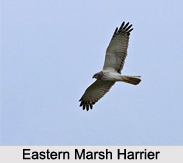 The Indian Subcontinent provides suitable habitats to various species of birds for residing and nesting. Harriers are no exception in this regard. Various types of harriers have been recorded in India. They belong to the kingdom, Animalia; phylum, Chordata; class, Aves; order, Accipitriformes; family, Accipitridae; and genus, Circus. These harriers are described below.
The Indian Subcontinent provides suitable habitats to various species of birds for residing and nesting. Harriers are no exception in this regard. Various types of harriers have been recorded in India. They belong to the kingdom, Animalia; phylum, Chordata; class, Aves; order, Accipitriformes; family, Accipitridae; and genus, Circus. These harriers are described below.
Western Marsh Harrier
Western Marsh Harrier (C. aeruginosus) is known to migrate to the Indian Subcontinent. The male Harrier is a reddish-brown bird. The bill of the bird is black. There are prominent lighter yellowish streaks present on the breast of the bird. The bird has yellow colored legs, feet and cere. The bird has mostly pale grayish-yellowish head and shoulders. The subspecies C. a. aeruginosus has been recorded in the Indian Subcontinent. The length of Western Marsh Harrier ranges from 40 to 55 cm and its weight ranges from 400 to 700 grams. The female bird is slightly larger and its weight ranges from 550 to 950 grams. The wingspan ranges from 115 to 145 cm.
The bird has yellow colored legs, feet and cere. The bird has mostly pale grayish-yellowish head and shoulders. The subspecies C. a. aeruginosus has been recorded in the Indian Subcontinent. The length of Western Marsh Harrier ranges from 40 to 55 cm and its weight ranges from 400 to 700 grams. The female bird is slightly larger and its weight ranges from 550 to 950 grams. The wingspan ranges from 115 to 145 cm.
Eastern Marsh Harrier
Eastern Marsh Harrier (C. spilonotus) winters in north-east India. The male bird has blackish head, breast, back and wing-coverts with pale streaks. The belly of the bird is mostly white. Its rump is also white in color. The female Harrier is recognized as a dark brown bird. The length of the bird ranges from 45 to 55 cm and its weight ranges from 350 to 800 grams. The wingspan ranges from 110 to 140 cm. The female harrier is slightly larger than the male.
Pallid Harrier
 Pallid Harrier (C. macrourus) winters mainly in the Indian Subcontinent. The male bird has whitish grey upper body and white lower body, with narrow black wingtips. The female counterpart has brown upper body. The upper tail coverts are white in color. The underparts are buff, streaked with brown. The length of the adult Harrier ranges from 40 to 48 cm (16 to19 in) and its wingspan ranges from 95 to120 cm (37-47 in). The male weighs 315 g (11.1 oz) whereas the slightly larger female weighs 445 g (15.7 oz).
Pallid Harrier (C. macrourus) winters mainly in the Indian Subcontinent. The male bird has whitish grey upper body and white lower body, with narrow black wingtips. The female counterpart has brown upper body. The upper tail coverts are white in color. The underparts are buff, streaked with brown. The length of the adult Harrier ranges from 40 to 48 cm (16 to19 in) and its wingspan ranges from 95 to120 cm (37-47 in). The male weighs 315 g (11.1 oz) whereas the slightly larger female weighs 445 g (15.7 oz).
Pied Harrier
The male and female Pied Harriers (C. melanoleucos) differ in terms of plumage color. The male Harrier is a pale grey bird. The color of its head is black. The bird has mantled back, upper breast and tail coverts. The length of the bird ranges from 40 to 50 cm and its weight ranges from 250 to 320 grams. The female bird is slightly larger and weighs 400 to 450 grams. The wingspan ranges from 110 to 125 cm.











